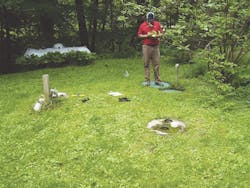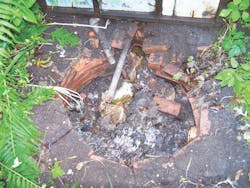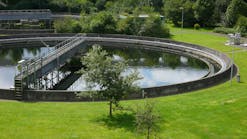Matt Summers is environmental scientist for Wenck. Summers can be reached at [email protected] or 651.395.5206.
Across the country, many of the areas with the worst wastewater infrastructure are small, unincorporated rural communities with no money, no formal staff and no experience managing large capital projects. So when the state’s pollution control agency (PCA) notifies one of these communities that it needs to address its wastewater issues at a potential cost of millions of dollars, what does the community do? Too often, the problem simply goes unmitigated.
The size of the problem is daunting. In Minnesota alone, the Minnesota PCA estimates there are more than 1,000 small, unsewered communities in the state—yet fewer than 10 get addressed every year.
With noncompliant sewers, these communities cannot grow. Most counties will not allow homeowners to sell their property, put on an addition, or pull a building permit if they do not have a compliant septic system. If an entire small town is non-compliant, it will eventually die if nothing is done.
In most unincorporated areas it is up to the township government, or the residents themselves, to take action. So, when faced with such a challenge, where do local residents begin?
Getting Organized
The residents living around Lake Zumbro in Olmstead County, Minn., are a perfect example. The small, unincorporated communities along its shores had a large percentage of properties with failing septic systems, and lot sizes often were too small to allow for individual system replacements. When state and local authorities identified these unsewered communities as sources of pollution for Lake Zumbro, the residents did not know where to begin.
The first step a township should take in this situation is to organize the residents. At Lake Zumbro, this process was made significantly easier due to the work of a local public-private partnership called the Southeast Minnesota Wastewater Initiative (SEMWI). This group provided, at no cost, community organizing staff who came in to organize and educate residents on the problem and potential solutions.
The assistance they provide is multifaceted:door-to-door recruitment and organizing, forming resident action committees, teaching public meeting rules and procedures, providing technical know-how, helping obtain funding and engineering services, engaging local and state authorities, advocating to political representatives, and more. SEMWI helped several communities on Lake Zumbro organize and address significant wastewater problems, and even helped obtain funding for these costly projects. For most of them, 70% to 80% of the total project cost was covered by public grants, and the rest with low-interest loans.
Most areas do not have a local nonprofit that specializes in providing wastewater facilitators. In that case, the only option is to find a local resident who is passionate about fixing the problem, and who has the time and ability to educate themselves and organize their neighbors. Such a resident can be rare. It is critical that a local, trusted person start the process and stick with it to the end. Those are the cases in which projects actually move forward. Wastewater projects often are contentious, expensive projects that can face significant resistance in the community. The per-property cost of a new sewer system (before public funding) might exceed the home values in some rural communities. The typical capital cost for a new public decentralized wastewater system can be around $50,000 or more per connection.
Having the community organizer be someone who will profit from the project is problematic because it takes a long time for a company with a profit motive and a vested interest in a project to develop trust—especially in small towns. A resident, trusted official or nonprofit organizer who will take the time to go door-to-door and meet in people’s houses, have town hall meetings, have coffee and dinner with people, and grow trust is a critical factor in the ultimate success of the project.
Another benefit of recruiting a local organizer is that paying a professional engineering firm to do the organizing and initial technical work usually is prohibitively expensive. Door-to-door organizing is time consuming, and paying an engineering firm more than $100 per hour to do it is simply not feasible. In rural communities, where a local organizer cannot be recruited and nonprofits cannot help, hiring a small solo practitioner engineer or operator may be a more affordable solution for the pre-work.
Regardless of who does the organizing, getting residents on the same page and in agreement about fixing the problem is a critical first step because the initial phase of work, before professionals can be brought on board to take over, is too much work for one person to handle without the support of the community.
Scoping the Project
Once a local sewer committee is formed, the committee can start the process of scoping out and securing funding for the project. Many states have dedicated funds available for wastewater infrastructure projects. However, applying for and obtaining that funding requires technical expertise and an organized community. It is a catch-22—a community cannot get funding without getting organized, but cannot get organized without funding or free help. Often, these communities simply do nothing.
For instance, the state of Minnesota maintains a project priority list (PPL) that assigns a priority ranking to the wastewater projects that have been submitted for funding requests. This prioritization is done based on a score determined through initial engineering assessments that must be completed along with the application. When it comes to the list, the higher a project scores, the more likely it is to get initial funding. The Minnesota 2017 PPL list includes approximately 320 communities. Each year there might be only a few dozen shovel-ready projects on the list that receive funding.
This initial assessment is technical, and often involves a thorough review of county permit records, a drive-by of all the subject properties, mapping of site locations, and an assessment of whose systems are compliant and noncompliant. Funding also is impacted by home density, local median income data and other factors. It is a technical process that is overly burdensome for someone without the expertise to tackle it.
This is the step that causes most noncompliant wastewater systems to go unmitigated. In the case of Lake Zumbro, the SEMWI helped get the process moving, but when left to residents, a project like this can languish for years until the threat of enforcement action from a state agency forces a community to take action.
In Minnesota, a community can apply for a Small Communities Technical Assistance grant for up to $60,000 to contract with an engineer for a detailed wastewater infrastructure compliance survey and feasibility and cost assessment of any potential solutions. To get this initial $60,000 study grant, however, a community must already be on the state’s PPL. Again, it is a takes-money-to-get-money situation, and availability of similar programs varies by state.
This study provides potential project cost estimates that then are used to apply for infrastructure funding. The report then is submitted to the PCA for review and comment. A community meeting must be held to present the findings and some of the alternatives to the decision-making body—usually the township board, but sometimes a county board or a special district board. Hiring an engineer to conduct the community assessment and cost out potential solutions involves drafting a request for proposals, sending it out to known firms, and going through an interview and hiring process. This can be a big challenge for a small, unorganized community not experienced in hiring and managing consultants. Again, this is where an organization like the SEMWI is invaluable.
There are tens of thousands of communities around the country with non-compliant or inadequate wastewater systems that are polluting the local environment and keeping their communities stuck in time. Fixing them is crawling along at a snail’s pace. The good news is that the money to deal with problem wastewater infrastructure is out there. In fact, many states are even looking at expanding the available pool of money for shovel-ready projects. Cost should not be an obstacle. A good consultant partnered with a passionate grassroots organizer is the fastest way to get a project funded and completed. It worked for the residents of Lake Zumbro.
Other Potential Resources
- County staff can be a resource for communities working through wastewater projects. Even if they will not provide any financial assistance, it is a good idea to keep the county in the loop. Many counties will forgo enforcement action against non-compliant properties if an active effort to get compliant is underway.
- Check with the local public university system. In Minnesota, the University of Minnesota (U of M) and its extension offices offer some technical assistance and can be a good resource for communities that do not have other options. Often universities will have pamphlets and guides that help walk communities through checklists of the things they need to do.
- Research potential federal programs that might operate in the area. For instance, the Midwest Assistance Program, based out of the department of Agriculture, provides community organizers in some situations. However, turnover can be high, and losing an organizer mid-project can derail a project’s efforts. It is far better to have a local person who will be consistent throughout the project.
- Request-for-proposal (RFP) help may be available from the local university system. In Minnesota, the U of M onsite sewage treatment program can help write an RFP.
- Check references. Verify what consultants say in their proposals, look up references and make sure they are legitimate. Midway through a project is no time to discover the consultant exaggerated their track record or capabilities.




